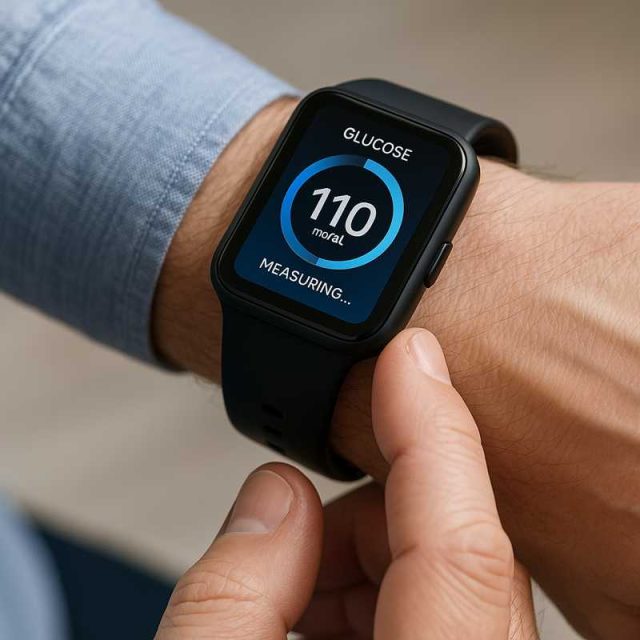
By Max Kopp
Managing type 2 diabetes requires daily diligence—but too often, the tools we give patients make that diligence harder. Fingerstick testing remains the norm for millions, while access to continuous glucose monitors (CGMs) is limited by cost, insurance restrictions, and discomfort with sensor insertion. This is despite CGMs being widely recognized as one of the most impactful tools in diabetes self-management.
For people with type 2 diabetes who are not using insulin—especially those in underserved communities—the gap between what’s clinically recommended and what’s realistically used is vast. Many avoid monitoring not because they don’t care, but because the process is painful, stigmatizing, or unaffordable.
That’s the challenge I set out to address as a student researcher in biomedical innovation. My focus: developing a non-invasive, AI-enhanced glucose sensing system that removes barriers and makes monitoring more patient-friendly, consistent, and accessible.
From Puncture to Photonics: Rethinking the Sensor
At the core of our innovation is photoplethysmography (PPG), a light-based sensing technique familiar from pulse oximeters and smartwatches. PPG measures changes in blood volume beneath the skin by analyzing light absorption and reflection. While traditionally used for heart rate and oxygen levels, I adapted this approach to detect glucose-related changes in skin reflectance.
To enable this, we combined PPG with inkjet-printed nanomaterials—specifically, Germanium Selenide (GeSe), a light-sensitive semiconductor suited for wearable applications. Paired with optical sensors, these materials detect subtle fluctuations linked to glucose concentrations.
Unlike traditional CGMs, this system is entirely non-invasive. There are no needles, patches, or adhesives. Users wear a small, wrist-mounted sensor—similar to a fitness tracker—that captures continuous readings through light and interprets them using machine learning models.
AI-Powered Personalization: Understanding the Individual
Collecting glucose data is just the first step. The real innovation lies in how we interpret it.
Our system uses AI algorithms that adapt to each user’s physiology. Variables like skin thickness, hydration, and light absorption vary between people—and even over time. To account for this, our platform continuously trains its model using contextual inputs like heart rate variability, skin temperature, and circadian patterns. These help improve accuracy and reliability over time.
The goal is a system that passively adapts to the user, requires minimal input, and generates clinically meaningful insights—without the burden of traditional monitoring.
Clinical Impact: Reaching the Unmonitored Majority
This technology has particular value for a largely overlooked group: people with type 2 diabetes who do not regularly monitor glucose. While CGM adoption is increasing among insulin users, uptake remains low among those treated with oral agents or lifestyle changes alone.
Many of these individuals are assumed to be “controlled” but experience hidden glucose swings. Missed hyperglycemia, delayed feedback on food choices, and gaps in provider insight all contribute to suboptimal care.
A non-invasive system could close that gap by:
- Removing fear and discomfort from the equation
- Supporting early intervention and trend detection
- Enhancing remote monitoring and care coordination
- Providing actionable data for behavior change and medication adjustments
Several diabetes educators I’ve spoken with have noted that such a tool would be especially powerful at the time of diagnosis, when resistance to invasive monitoring is high—and clinical inertia is most harmful.
Equity Through Affordability: Designing for Access
Too often, diabetes innovation targets the top of the market—tech-savvy, well-insured patients. But the burden of type 2 diabetes falls hardest on marginalized communities.
That’s why we’ve prioritized affordability in our design. The projected retail price of our device is under $250—a one-time cost with no consumables, no recurring sensor replacements, and no subscription fees. The system will pair with smartphones to leverage existing mobile infrastructure.
This model could dramatically expand access for:
- Medicaid or uninsured patients
- Community clinics and FQHCs
- Rural and remote populations
- Newly diagnosed individuals not yet on medications
Cost is among the top barriers to CGM use. By removing consumable costs and simplifying the hardware, we hope to make glucose monitoring sustainable—not just trial-worthy.
Where We Are: Early Success and Next Steps
This device isn’t commercially available yet. We’re currently in the prototype and calibration phase, running lab-based tests and training AI models on diverse user data.
So far, our early results show promising correlation between optical signals and glucose variability. Several mentors in clinical research and digital health have expressed interest in future pilot studies. We’re also initiating conversations with academic labs, public health partners, and funders to explore real-world testing.
Looking Ahead: Redefining Glucose Monitoring
What excites me most isn’t just the science—it’s the possibility of changing what glucose monitoring feels like. When patients say they don’t want to prick their fingers, they’re not being difficult—they’re expressing a real barrier. We owe it to them to find better solutions.
As clinicians, educators, and care teams, you understand the value of timely glucose data. But too often, the current tools are too intimidating or too expensive to use consistently. Our vision is to create something frictionless, affordable, and clinically meaningful.
That’s the future I want to help build—through research, partnership, and inclusive design.
To learn more or collaborate on this research, visit www.maxkopptech.com or www.thevitasense.com.
About the Author
Max Kopp is a high school junior at Germantown Academy and the founder of VitaSense, a healthtech startup developing non-invasive, AI-powered glucose monitoring systems. His research in nanomaterials and biomedical engineering has earned national recognition from organizations including the U.S. Navy, Air Force, and NASA. Max is passionate about advancing equitable, patient-friendly solutions for chronic disease care.